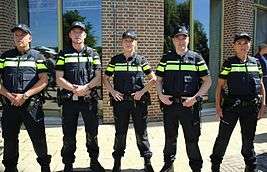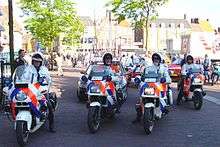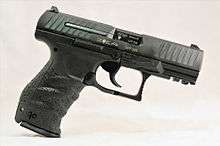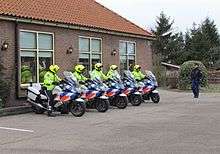Law enforcement in the Netherlands

Law enforcement in the Netherlands is provided by the National Police Corps (Dutch: Korps Nationale Politie), divided in ten regional units and a central unit, and the Royal Marechaussee (Dutch: Koninklijke Marechaussee), a gendarmerie.[1] Law enforcement in the Netherlands operates primarily through governmental police agencies. The law-enforcement purposes of these agencies are the investigation of suspected criminal activity, referral of the results of investigations to the courts, and the temporary detention of suspected criminals pending judicial action. Law enforcement agencies, to varying degrees at different levels of government and in different agencies, are also commonly charged with the responsibilities of deterring criminal activity and preventing the successful commission of crimes in progress. The Chief of Police (hoofdcommissaris) in The Netherlands is since March 1, 2016 Erik Akerboom.[2] In recent years the majority of local councils have employed their own Enforcement officers or "Handhaving". These officers have Special Enforcement Officer (SEO) status (Buitengewoon Opsporingsambtenaar) or BOA in Dutch and therefore have limited police powers (detaining suspects, ask for identification, make warrant less arrest, issue fines within their power of offences and use force).The majority of BOA officers have the authority to carry and use handcuffs which can only be issued to officers who have the power to use force. A few councils also issue their officers, with permission from the Ministry of Safety and Justice, police batons and occasionally pepper spray. Their main task is to enforce local ordinances, municipal code infractions, nuisances caused by noncriminal youth, several light traffic offences and anti-social behaviour. All these tasks are sometimes called "Enforcing the Small Standard," meaning offences without a criminal undertone and enforcing primarily non-threatening situations.
Organisation
From the end of 1945 until 1993, the Dutch police was composed of the municipal police (Dutch: gemeentepolitie) and the state police (Dutch: rijkspolitie). In 1994, the police was reorganised into 25 Regional Constabularies (Dutch: regiokorpsen) and a National Constabulary (Dutch: Korps landelijke politiediensten, KLPD). In 2013 the police in the Netherlands was reorganised again into its current structure.[3] In the event of serious emergencies, the police cooperates with the fire brigade,[4] ambulance service,[5] other government agencies and military forces in the security region corresponding to the police region.[6]
The regiokorpsen

Every regiokorps (regional constabulary) is led by a korpschef (corps chief), a Hoofdcommissaris (Chief Commissioner) who conducts the day-to-day police force management. Decisions about the principal law enforcement policies are made by a regional board, the so-called Driehoek (triangle) whose chairman is the korpsbeheerder (force manager). The korpsbeheerder is usually the mayor of the largest municipality in the region. The other board members of the Driehoek are the korpschef and the (chief) prosecutor.
A region consists of several districts, each having a district chief. Each district consists of a number of local units, called basiseenheden (basic units) or teams.
The "police strength", the number of constables and other police employees in a region is determined by the number of inhabitants and the amount of crime in the region. So the smallest force counts about 300 police officers, while the largest one counts more than 5000 police employees. There are about 55,000 police employees serving in the Netherlands.
Selected police officers may also be deployed in a riot police Mobile Unit. Mobile units are called in to deal with serious public order offenses. Each police region has one or more units on stand-by for a total of 45 mobile units nationwide, each of which has about 50 members (including middle-ranking and senior officers). Nine units have also been trained to respond to incidents on maritime vessels. The Mobile Unit also incorporates plain clothes units known as 'aanhoudingseenheden'. These groups target specific suspects of public order offenses.
Korps landelijke politiediensten

The Korps landelijke politiediensten (National Constabulary, KLPD) provides eleven operational services, including:
- Dienst Nationale Recherche (National Crime Squad)
- Dienst IPOL (National Police Intelligence Service - former DINPOL and DNRI)
- Dienst Specialistische Recherche Toepassingen (Special Investigative Services)
- Dienst Koninklijke en Diplomatieke Beveiliging (Royal and Diplomatic Security Service)
- Dienst Speciale Interventies (Special Intervention Service)
The KLPD is responsible for policing on the roads, waterways, railways and in the air. It also combats domestic and cross-border serious/organised crime and terrorism. For that last purpose the KLPD has operational command of all anti-terror police units. The national constabulary supports the regional police forces with specialised means such as police horse and dog teams; provides witness protection. A last task is the protection of members of the Dutch Royal Family and other dignitaries (e.g., diplomats and politicians) as assigned by the authorised minister.
Koninklijke Marechaussee
The Koninklijke Marechaussee (KMar) (Royal Gendarmerie) is one of the four services of the Armed forces of the Netherlands. It is a gendarmerie — that is, a military organisation which conducts the duties of a normal police force as well as being the police force to the armed forces. The Marechaussee is a fully military force under the responsibility of the Ministry of Defence. However it does not answer to the Chief of the Defence Staff, but directly to the minister of defence (to secure independence and impartiality when enforcing military law).[7]

The RNLM performs the following duties:
- assistance to and replacement of the police
- escorting and protection of NATO convoys
- fighting illegal immigration
- fighting international crime
- guarding the national borders
- guarding the royal palaces and the Catshuis, the official residence of the Prime Minister
- military police functions for the Dutch Armed Forces
- riot control and protection
- security and police work at all civilian airports, notably Schiphol Airport
- VIP close protection including the Royal Family and high-ranking government officials
- Special Protection Assignments Brigade (BSB), special forces for arrests, surveillance and protection
- KMOO, the Military Police Service

The first four units are territorial, other two have national rather than regional responsibilities. The Marechaussee also provides general policing at Schiphol airport and its surrounding area -known as 'Schiphol-Rijk', in addition to border control duty at the airport itself.
The Marechaussee also carries ceremonial duties at royal palaces, such as when new diplomats present their Letters of Credence to the King, and to escort important guests.
Military tasks are to guard military (including NATO) bases, to provide police service to military personnel, to assist military transports and civil and military law enforcement. A last duty is to reinforce and support the civil police when extra manpower or a higher escalation in the use of force is needed. To this end the KMar has its own Riot units; its own teams to make arrests and the BSB (see above). The KMar has some armoured car units to perform such duties.
KMar subunits usually accompany units of the Armed forces of the Netherlands on deployment and they are especially well represented in the Police Training mission in the Afghan Kunduz province where they lead the training of the ANP.
Ranks
Ranks of the Dutch police
Within the Dutch police the following ranks are in use: [8]
| Rank | First Chief Commissioner (Eerste Hoofdcommissaris) |
Chief Commissioner (Hoofdcommissaris) |
Commissioner (Commissaris) |
Chief Inspector (Hoofdinspecteur) |
Inspector (Inspecteur) |
Sergeant (Brigadier) |
| Shoulder | ||||||
| Sleeve |  |  |  |  |  |  |
| Rank | Senior Constable (Hoofdagent) |
Constable (Agent) |
Police Patrol Officer (Surveillant) |
Police Trainee (Aspirant) |
Non Executive Employee (Niet-Executieve Medewerker) | |
| Shoulder | ||||||
| Sleeve |  |  |  |  |  |
Police trainees are armed with a handgun when they pass their handgun training, if not the trainee performs his/hers duties unarmed (pepperspray,handcuffs and baton).
Ranks of the Royal Marechaussee
The ranks within the Royal Marechaussee are:
General Officers, National Level:
- Lieutenant General (commander in chief Royal Marechaussee)
- Major General (deputy commander)
- Brigadier General (usually head of department of the Royal Marechaussee Staff)
Senior officers, District Level:
- Colonel ("district commander")
- Lieutenant-colonel (deputy district commander, mostly in charge of a district staff department)
- Major (brigade commander / squadron commander)
Officers, Brigade Level:
- Captain (comparable to Chief Inspector)
- First Lieutenant (comparable to Inspector)
- Second Lieutenant
Executive personnel:
- Warrant Officer (WO1) (comparable to Inspector) - Dutch rank: Adjudant
- Sergeant Major (WO2) - Dutch rank for mounted arms: Opperwachtmeester
- Sergeant First Class - Dutch rank: Wachtmeerster der eerste klasse, or: Wachtmeester-1
- Sergeant (comparable to Constable) - Dutch rank: Wachtmeester
- Marechaussee First Class (compared to Patrol Officer)
- Marechaussee Second Class
- Marechaussee Third Class
- Marechaussee Fourth Class (comparable to Police Trainee)
Equipment

Basically the equipment of every Dutch police officer consists of the following:
- Lips or S.P.E. type handcuffs
- Short 30 cm baton
- Pepper spray
- Walther P99Q NL (H3) (Standard issue sidearm of all policemen, including Arrest- and Supportunit officers)[9][10]
- C2000 radio
Personnel from the rank of Constable (Agent) and also some trainees (Aspirant) carry a firearm.
The German-made Walther P5 was use since 1978 while Arrest- and Supportunits were armed with the Austrian-made Glock 17 pistol and/or a submachine gun, usually the German-made Heckler & Koch MP5.
It was originally planned to be replaced by the SIG Sauer PPNL, a 9×19mm Parabellum version of the SIG Sauer P250, but the contract was canceled due to the failure of several safety tests.
The personnel serving with the Royal Marechaussee is still equipped with the Glock 17 pistol and/or the Hecker & Koch MP5.
Vehicles

- Audi A4 (Arrest and Support unit)
- Audi A4 Sedan (security of the Royal House and politicians)
- Audi A6 (unmarked police)
- BMW 5 Series (special firearms team or security of the Royal House and politicians, Arrest and Support unit)
- BMW X5 (Arrest and Support unit, Royal House/politicians security)
- Ford F350 (Arrest and Support unit)
- Jeep Wrangler (Mobile Unit)
- Mercedes-Benz C-Class sedan (unmarked traffic police)
- Mercedes-Benz E-Class (unmarked (traffic) police)
- Mercedes-Benz G-Class (armoured vehicle, 4x4 vehicle of the security unit of the Royal Marechaussee, unmarked and marked)
- Mercedes-Benz Sprinter (mostly used by the unit "accident analysation")
- Mercedes-Benz Vario (for the transport of special bomb dogs, semi-unmarked)
- Nissan Patrol (armoured vehicle, 4x4 vehicle or not armoured for beach patrols)
- Opel Astra (normal patrol car of the Royal Marechaussee, many times on airports)
- Opel Insignia (unmarked police)
- Opel Vivaro (forensic teams or dog transport, sometimes still in use as police patrol van)
- Škoda Superb (unmarked police)
- Toyota Land Cruiser (armoured and unmarked vehicle for special security operations)
- Volkswagen Amarok (4x4 vehicle)
- Volkswagen Caddy
- Volkswagen Crafter
- Volkswagen Golf (for normal surveillance and also as unmarked police)
- Volkswagen Golf GTD (traffic police)
- Volkswagen Golf Plus (not used in the whole country)
- Volkswagen Golf Variant (for normal patrols) Volkswagen Passat Variant
- Volkswagen Polo (also as unmarked car for normal patrols)
- Volkswagen Passat (also as unmarked police)
- Volkswagen Transporter (T5) (unmarked for special firearms teams and marked for normal patrol)
- Volkswagen Touran (standard patrol car and also as unmarked police)
- Volkswagen Touareg (armoured vehicle for airports and political buildings)
- Volvo S60 (for personnel of the Royal House)
- Volvo V50 (traffic police, getting out of service)
- Volvo V70 (marked traffic police and unmarked traffic police) Volvo V70
Tasks
.jpg)
Since 2012, the new Dutch Police Law (Politiewet 2012) passed. The article which describes the police, has been changed from article 2, to article 3.
Article 3 of the Dutch Police law describes what the missions of the police are: "The task of the police is to, in subordination to the authorities and complying with applicable law, take care of the actual upholding of the legal order and to supply aid to those who need it." In practice this is comes down to four main missions.
- Prevention (preventing offences and crimes)
- Investigation of crimes and offences
- Upholding the legal order
- Supplying assistance to civil authorities
Within the police, several departments are occupied with parts of these main tasks.
Communications centre
The communications centre is sometimes called the heart of the police force. All calls to the emergency telephone number 112 and the national police number 0900-8844 come in here around the clock.
The people of the communications centre have to judge the calls in such a way that something is done, fast and properly. If a call is serious, an employee in the communications centre will have to directly choose which police officers are to be dispatched to the address. The communications centre employees know exactly where all the members of the force on the street are.
The calls coming into the communications centre are dispatched according to a number of criteria, resulting in so called priorities. Four priorities are defined.
- Priority number one: a life-threatening situation where police assistance is required within fifteen minutes.
- Priority number two: an arrival time of thirty minutes is required.
The other two priorities are dispatched to the neighbourhood officer.
Systems in use
For a number of years, the communications centres have used the Gemeenschappelijk Meldkamer Systeem (Common Communications Centre System, GMS). This system has a lot of functions. In the first place it functions as a plotting screen which displays every unit logged in. It also has a database function for procedures and phone numbers necessary for correctly executing police work and it links to the C2000 system and the CityGIS (GPS) system.
C2000 is the digital, secure communications system and, with CityGIS, police cars can be tracked on a map using GPS, which can be reported to the communications centre using a VDO navigation system.
Basic police work
In the Netherlands basic police work consists of the following tasks:
- Visible public policing: being visibly present on the street, on foot or in a marked car, prevents people from committing offences and crimes.
- Basic detective work: investigating petty thefts and burglaries is part of basic police work; when the case takes up too much time, it is transferred to the special branch.
- Giving crime prevention advice: giving advice on how to deter burglaries, advising municipalities on traffic issues, consultancy, etc.
- Providing assistance: assistance is provided to those who ask for it but also to game wardens, municipalities and other civil authorities etc.
- Dealing with traffic issues: traffic surveillance, handling traffic accidents, advising citizens and municipalities, traffic congestion security.
- Maintaining laws and regulations (often in conjunction with the special service): e.g., checking if foreigners are in possession of the right documents (visa, residence permit, work permit etc.) in cooperation with the immigration service.
- Special tasks: apart from daily activities a few special tasks are part of basic policing; these are executed independently or in conjunction with normal police activities, like the vice squad.
- National, (inter)regional investigations: investigating serious crimes such as murder, drug trafficking, trafficking in human beings, youth delinquency, arms trade, fraud, big environmental cases and sexual offences; the detectives are often supported by specialists.
- Information management: gathering and processing technical information (such as photographs and finger prints) and information about criminal organisations by for example the Criminele Inlichtingen Eenheid (Criminal Intelligence Unit, CIE).
- Aliens: issuing residence permits and supervising people staying in the Netherlands who don't have Dutch citizenship.
- Environmental service: because environmental law is complex, this is a specialist mission. In several Dutch municipalities these tasks are entrusted to a special Milieupolitie (Environmental police).
- Operational support tasks: tasks that support basic law enforcement or specialist tasks, such as police horse and dog care, the Mobiele Eenheid (Mobile Unit, riot control), Aanhoudings- en Ondersteuningseenheid" (Arrest and Supportunit, established for high-risk arrests) and observatieteams (observation teams, OT; comparable to ).
The Dutch government is keen to put more and more police "on the street". This means that the use of ICT will have to be improved so that constables do not lose a lot of time noting all their observations on paper for later use. The uniformed policemen on the street are those of the patrol service.
Sometimes police patrols drive directly from the communications centre to the location where someone requested assistance. This can be a simple case of someone locking their keys inside their car, a complaint about litter or an incoveniently parked car. There are also more serious calls that need direct attention, like an accident with injuries, a stabbing, a burglary, vandalism; all events where the police has to act and reassure.
Surveillance is not only done from the patrol car, but also from a motorbike or a horse. Especially in crowded malls surveillance is often done on foot or (motor)bike. The men and women on the street have to permanently "keep their eyes open" to spot suspicious behaviour, such as someone walking around looking inside parked cars, cars without working lights or drunken cyclists.
Car owners are told that their lights are broken and why this is dangerous. A constable on foot may tell shop owners to put locks on their shelves outside to prevent shoplifting. If you report on a stolen bike, you'll be told what kind of bike locks are most effective.
The police in a municipality are available 24 hours every day for basic law enforcement. More and more often the police will visit schools to teach pupils about drug prevention, vandalism or sex on the internet. The police in a municipality make sure that what is forbidden isn't done, and that which is mandatory is actually done. They also make sure that anyone who asks for assistance gets it, supported by personnel from the district and the region. Since the early 90s several police regions have been working with neighbourhood teams called neighbourhood supervisors.
Powers
The police have powers "ordinary" people do not have; e.g., an officer can stop or arrest people, or look in a shopping bag for lifted items, or (on authorization of the assistant prosecutor) search a home for arms. The police also have the power to use force. This power is often called the "monopoly on force". The police is one of the few organisations in the Netherlands that are allowed to use force, the use of which is bound by many rules and preconditions.
The power to stop someone is often confused with the power to arrest someone. The power to stop someone is the power of the police to make someone stand still, so that the police can ask for his name and address.
The power to stop someone is the power that enables the arrest of someone. However, this power is not only granted to the police. The Code of Criminal Procedure, article 53, sub 1, reads:
In case of discovery in the act everyone is authorized to stop the suspect.
The term "in the act" meaning "when it just happened".
Stopping someone means holding the suspect while waiting for the arrival of the police. When someone is stopped, he is always brought to a police station for questioning.
The investigative powers of the police are for example described in the Police Law, the Arms and Munitions Law, the Opium Law, the Road Traffic Law 1994, the Entry Law and the Code of Criminal Procedure.
These powers are bound by very strict rules. Some of these powers may be applied by an officer himself, like the examples before. Other police powers, like wiretapping, observation or searching premises, can only be used after permission is granted by the examining judge.
Cooperation with other services
When providing aid the police cooperates with other services. When dealing with an accident for example, the police cooperates with ambulance services, doctors and the fire brigade. The police also cooperate with the Koninklijke Marechaussee.
Slachtofferhulp
For providing support to victims the police cooperates with the Bureaus Slachtofferhulp (comparable to Victim Support). The employees of Slachtofferhulp are specially trained to provide support to victims of accidents and crime. They make sure that victims are coached, but they also help with filling in forms for insurance or a lawyer.
Continuing support
The police cooperates closely with support organisations that can continue providing support when the abilities of the police to do so come to an end. A few examples:
- Addiction care like the Consultatiebureau voor Alcohol en Drugs, Kentron or Novadic.
- Mental health Care (for people who, e.g., want to commit suicide or are a danger to others)
- The Reclassering Nederland (the Dutch parole office)
- The youth parole office
- The Raad voor de Kinderbescherming (comparable to the Children and Family Court Advisory and Support Service)
- Social work, e.g., in case of domestic violence
See also
References
- ↑ "Over de politie". Retrieved 2016-11-03.
- ↑ "Korpschef Erik Akerboom". Retrieved 2016-11-03.
- ↑ Interpol profile on Netherlands Police Interpol.int
- ↑ NVBR. "Over de brandweer". www.brandweer.nl (in Dutch). Retrieved 2016-11-03.
- ↑ "Ambulancezorg Nederland".
- ↑ "Organisatie: één politie, elf eenheden". Retrieved 2016-11-03.
- ↑ Defensie, Ministerie van. "Koninklijke Marechaussee". www.defensie.nl (in Dutch). Retrieved 2016-11-03.
- ↑ NPI, Policing in the Netherlands, Leiden: Drukkerij de Bink 2004
- ↑ "Nieuw pistool voor Nederlandse politie, www.rijksoverheid.nl (Dutch)". 2012-10-26. Retrieved 2012-10-26.
- ↑ "Brief Tweede Kamer Voorlopige gunning nieuw dienstpistool politie, www.rijksoverheid.nl (Dutch)" (PDF). 2012-10-25. Retrieved 2012-10-26.
External links
| Wikimedia Commons has media related to Police of the Netherlands. |